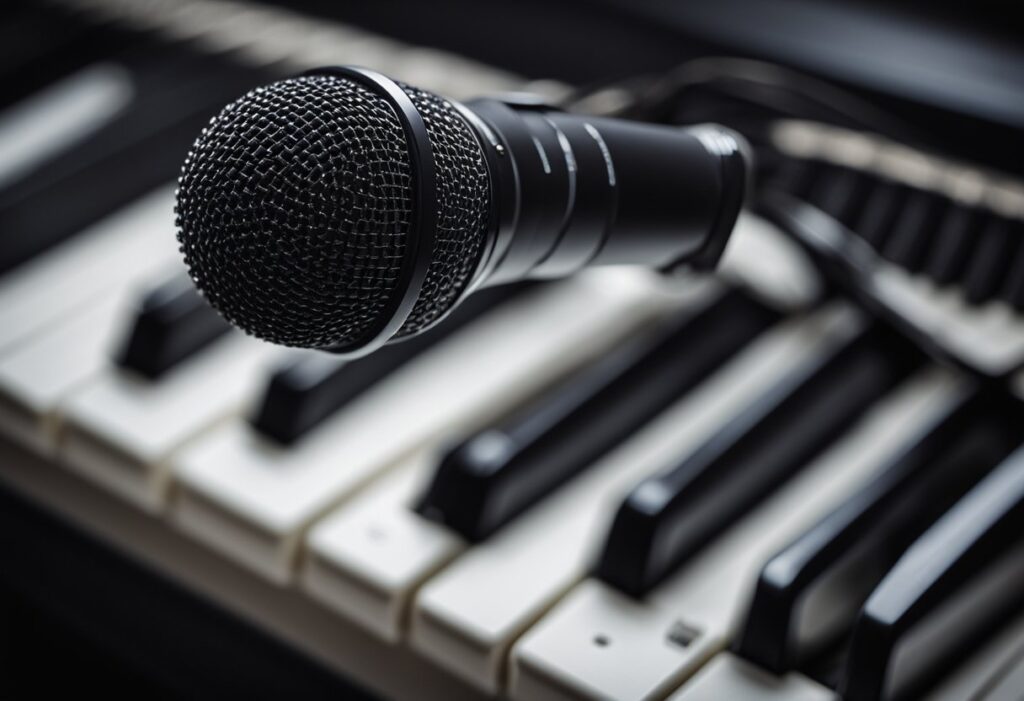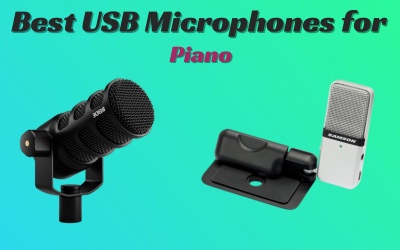If you’re a musician looking to record your piano playing, you may be wondering how to troubleshoot USB microphone issues with a piano. USB microphones are a popular choice for recording audio, but they can be finicky when it comes to compatibility with different devices. Fortunately, with a little bit of know-how, you can get your USB microphone up and running with your piano in no time.
In this article, we’ll walk you through the steps to setting up your USB microphone with your piano, as well as how to troubleshoot any issues that may arise. We’ll cover everything from basic connectivity to advanced troubleshooting techniques, so you can get the most out of your recording setup. Whether you’re a seasoned pro or a beginner, this guide will help you get the most out of your USB microphone and piano recording setup.
Table of Contents
ToggleUnderstanding USB Microphone Connectivity

If you are experiencing issues with your USB microphone while using it with a piano, it is important to understand the basics of USB microphone connectivity. This will help you troubleshoot and fix any issues that may arise.
Checking USB Ports and Cables
The first step in troubleshooting USB microphone connectivity issues is to check the USB ports and cables. Make sure that the USB cable is properly connected to the microphone and the computer, and that the ports are not damaged. If the cable is damaged, replace it with a new one.
If you are using a USB hub, try connecting the microphone directly to the computer instead. USB hubs can sometimes cause connectivity issues, especially if they are not powered.
Driver Installation and Updates
Another common cause of USB microphone issues is outdated or missing drivers. Make sure that you have installed the correct drivers for your microphone and that they are up-to-date. You can usually find the latest drivers on the manufacturer’s website.
If you are using Windows, you can check the device manager to see if there are any driver issues with your microphone. Right-click on the Start button and select “Device Manager.” Look for the “Audio inputs and outputs” section to find your USB microphone. If there is a yellow exclamation mark next to the microphone, it indicates a driver issue. Update the driver by right-clicking on the USB microphone and selecting “Update Driver Software.”
Related Posts:
Setting Up Your USB Microphone with a Piano
If you want to record your piano playing with a USB microphone, there are a few things you need to consider. Here are some steps to help you set up your USB microphone with your piano:
Optimal Microphone Placement
The first thing you need to do is find the optimal placement for your USB microphone. You want to place it in a position where it can capture the sound of your piano accurately. The best placement for your microphone depends on the type of piano you have.
For example, if you have an upright piano, you may want to place the microphone on top of the piano, facing down towards the strings. If you have a grand piano, you may want to place the microphone inside the piano, near the hammers.
Audio Interface Configuration
Once you have found the optimal microphone placement, you need to connect your USB microphone to an audio interface. An audio interface is a device that converts the analog signal from your microphone into a digital signal that your computer can understand.
You can connect your USB microphone directly to your computer, but an audio interface will provide better sound quality.
Software Settings for Piano Recording
After you have connected your USB microphone to an audio interface, you need to configure your software settings for piano recording. You can use any digital audio workstation (DAW) software to record your piano playing. Some popular DAWs include GarageBand, Logic Pro, and Pro Tools. You need to make sure that your DAW is set up to record from your USB microphone and that the input levels are set correctly.
Related Posts:
- Guide to dual USB microphone setup for recording piano duets
- How to connect USB mic to electric piano
How to troubleshoot USB microphone issues with a piano

If you are having trouble recording audio from your piano using a USB microphone, there are a few things you can do to troubleshoot the issue. Here are some steps you can take to resolve common problems:
Resolving Audio Latency
Latency is the delay between the time you play a note on your piano and the time you hear it through your computer’s speakers. This can be especially problematic when recording music, as it can make it difficult to keep your timing consistent. To resolve latency issues, try the following:
- Lower the buffer size in your recording software settings
- Close any unnecessary programs or applications running on your computer
- Use a dedicated audio interface instead of your computer’s built-in sound card
Eliminating Background Noise
Background noise can be a major problem when recording audio, especially if you are using a sensitive USB microphone. To eliminate background noise, try the following:
- Move your microphone closer to your piano and further away from any noise sources
- Use a noise gate plugin in your recording software to filter out unwanted noise
- Invest in a high-quality microphone with good noise-cancelling capabilities
Fixing Distortion and Clipping
Distortion and clipping can occur when the volume of your piano is too high for your microphone to handle. To fix these issues, try the following:
- Lower the volume of your piano or move your microphone further away from it
- Use a compressor plugin in your recording software to even out the volume levels
- Invest in a higher-quality microphone with a higher maximum sound pressure level (SPL) rating
By following these troubleshooting steps, you should be able to resolve most USB microphone issues when recording audio from your piano.
Related Posts:
Advanced Troubleshooting Techniques
If basic troubleshooting techniques fail to solve your USB microphone issues with a piano, you may need to try some advanced techniques. Here are two options:
Firmware Reinstallation
If your USB microphone is still not working after trying all basic troubleshooting techniques, you may need to reinstall the firmware. Firmware is the software that runs on the USB microphone’s hardware.
To reinstall the firmware, visit the manufacturer’s website and download the latest version of the firmware for your USB microphone. Follow the instructions provided by the manufacturer to install the firmware. This process may vary depending on the manufacturer, so be sure to carefully read the instructions before proceeding.
Hardware Diagnostics
If you have tried all the basic troubleshooting techniques and firmware reinstallation, but your USB microphone is still not working with your piano, you may need to perform hardware diagnostics. Hardware diagnostics will help you determine if there is a problem with your USB microphone’s hardware.
To perform hardware diagnostics, you can use a diagnostic tool provided by your USB microphone’s manufacturer. This tool will test your USB microphone’s hardware and provide you with a report on any issues found. Follow the instructions provided by the manufacturer to use the diagnostic tool.
Alternatively, you can use Windows or Mac’s built-in hardware diagnostic tools. On Windows, open the Device Manager and select your USB microphone. Right-click on it and select “Properties.” Click on the “Driver” tab and select “Update Driver.” On Mac, go to “System Preferences” and select “Hardware.” Click on “USB” and select your USB microphone. Click on “Info” and select “Diagnostics.”
Note that hardware diagnostics may require some technical expertise. If you are not comfortable performing these tasks, you may want to seek the help of a professional technician.
Conclusion
In conclusion, troubleshooting USB microphone issues with a piano can be a challenging task. However, by following the steps outlined in this article, you can easily identify and resolve any issues you may encounter. Remember to check your operating system settings, ensure that your microphone is selected as the default input device, and check your connections. If you continue to experience issues, consider consulting a professional. With a little patience and effort, you can achieve high-quality recordings of your piano performances.
Frequently Asked Questions
What steps can I take to fix a USB microphone that isn’t being recognized by my computer?
If your USB microphone isn’t being recognized by your computer, try the following steps:
- Check if the USB cable is connected properly to both the microphone and the computer.
- Try connecting the USB microphone to a different USB port.
- Restart your computer and try connecting the USB microphone again.
- Check if the USB microphone is compatible with your operating system.
Why isn’t my USB microphone producing any sound when connected to my piano?
If your USB microphone isn’t producing any sound when connected to your piano, try the following steps:
- Check if the microphone is turned on and the volume is turned up.
- Ensure that the microphone is selected as the input device in your recording software.
- Check if the microphone is compatible with your piano and recording software.
- Try connecting the microphone to a different USB port.
How can I resolve audio quality issues with my USB microphone while recording piano?
To improve the audio quality of your USB microphone while recording piano, try the following steps:
- Ensure that the microphone is positioned correctly to capture the sound of the piano.
- Use a pop filter to reduce unwanted noise and improve clarity.
- Adjust the gain and volume levels to achieve the desired sound.
- Try using a different recording software or adjust the settings in your current software.
What should I do if my computer’s recording software doesn’t detect my USB microphone?
If your computer’s recording software doesn’t detect your USB microphone, try the following steps:
- Ensure that the microphone is connected properly to the computer.
- Check if the microphone is selected as the input device in your recording software.
- Update your recording software to the latest version.
- Check if the USB microphone is compatible with your recording software.
How do I fix latency problems with a USB microphone when playing and recording piano?
If you’re experiencing latency problems with your USB microphone when playing and recording piano, try the following steps:
- Reduce the buffer size in your recording software to reduce latency.
- Close any other applications that may be using your computer’s resources.
- Try using a different USB port or cable to connect the microphone.
- Upgrade your computer’s hardware if it’s outdated.
What common troubleshooting methods can I apply if my USB microphone keeps disconnecting during use?
If your USB microphone keeps disconnecting during use, try the following steps:
- Ensure that the USB cable is connected properly to both the microphone and the computer.
- Try using a different USB port or cable to connect the microphone.
- Update your computer’s drivers to the latest version.
- Check if the USB microphone is compatible with your operating system.








